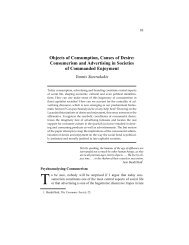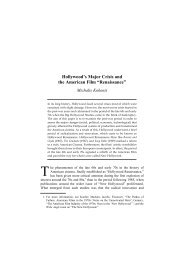19 International Symposium on Theoretical and Applied Linguistics ...
19 International Symposium on Theoretical and Applied Linguistics ...
19 International Symposium on Theoretical and Applied Linguistics ...
Create successful ePaper yourself
Turn your PDF publications into a flip-book with our unique Google optimized e-Paper software.
G E N E R A L S E S S I O N<br />
Equivalence (?) in translati<strong>on</strong>: exploring timelines<br />
Christine Calfoglou<br />
Hellenic Open University<br />
xkalfog@otenet.gr; xkalfog@yahoo.gr<br />
In this paper we present data drawn from a sizeable ‘comparable bilingual’ as well as ‘parallel text’<br />
corpus (Bernardini et al. 2003) of Greek <strong>and</strong> English web-based European Uni<strong>on</strong> <strong>and</strong> history<br />
timelines. With a view to establishing translati<strong>on</strong> equivalence, we adopt an ic<strong>on</strong>icity orientati<strong>on</strong><br />
(Fischer & Nänny <str<strong>on</strong>g>19</str<strong>on</strong>g>99, Tabakowska <str<strong>on</strong>g>19</str<strong>on</strong>g>99, Ljungberg & Tabakowska 2007 am<strong>on</strong>g others) <strong>and</strong><br />
explore the frequency with which ic<strong>on</strong>ic ‘basic instance level’ sequences (Firbas <str<strong>on</strong>g>19</str<strong>on</strong>g>92) involving<br />
postverbal subjects, as in ‘υιοθετείται ένα πρόγραµµα ...’ or ‘αρχίζουν οι συνοµιλίες ...’, occur in the<br />
Greek data, as well as the degree to which these sequences alternate with nominalizati<strong>on</strong>s like<br />
‘έναρξη των συνοµιλιών ...’ in Greek <strong>and</strong>, most importantly, in English, where the postverbal subject<br />
possibility is practically unavailable. Somehow by analogy to postverbal subject sequences of the type<br />
presented above, nominalised sequences are also hypothesized to be a more ic<strong>on</strong>ic alternative than<br />
their subject-initial counterparts, as in ‘a programme … is adopted’ or ‘talks begin’, in the sense that<br />
they leave the ‘juicy’ informati<strong>on</strong>, in this case the ‘of-phrase’, last. It may thus be expected that in a<br />
timeline c<strong>on</strong>text free of presupposed informati<strong>on</strong> <strong>and</strong> thus licensing ‘basic level instances’,<br />
nominalizati<strong>on</strong>s will act as a dynamic alternative to subject-initial structures rhematising the<br />
semantically ‘poor’ clausal element. Data inspecti<strong>on</strong>, however, reveals a far from neat tax<strong>on</strong>omy, with<br />
nominalizati<strong>on</strong>s shared rather inc<strong>on</strong>sistently between ‘basic instance’ <strong>and</strong> rhematic uses (the latter as<br />
in ‘ακµή του Μινωικού πολιτισµού’) <strong>and</strong> subject-initial structures holding sway in the English corpus,<br />
stylistic choices apart, which makes equivalence in translating timelines a hazy issue. It is suggested<br />
that the trends observed in each of the two languages, al<strong>on</strong>g with stylistic idiosyncrasies, need to be<br />
carefully c<strong>on</strong>sidered in producing a translati<strong>on</strong> output, which may entail a delicate trade-off between<br />
L1 faithfulness <strong>and</strong> L2 acceptability (cf. Calfoglou to appear). The multiplicity of variables codetermining<br />
‘basic instances’ in the genre is discussed <strong>and</strong> the relevance of alternative forms of ic<strong>on</strong>ic<br />
arrangement, like that of the SVO narrative (C<strong>on</strong>radie 2001), in translating the genre are c<strong>on</strong>sidered.<br />
Finally, attenti<strong>on</strong> is drawn to the potential (L1) bias of parallel texts <strong>and</strong> the importance of the insight<br />
gained via bilingual corpora.<br />
The Greek NooJ module<br />
1 Elina Chadjipapa, 2 Eleni Papadopoulou & 3 Zoe Gavriilidou<br />
1&2 Universidad Aut<strong>on</strong>oma de Barcel<strong>on</strong>a & 3 Democritus University of Thrace<br />
1 elinaxp@hotmail.com, 2 Eleni.Papadopoulou@uab.cat & 3 zoegab@otenet.gr<br />
NooJ (http://www.nooj4nlp.net/) is a linguistic development envir<strong>on</strong>ment that includes largecoverage<br />
dicti<strong>on</strong>aries <strong>and</strong> grammars, parses corpora in real time, <strong>and</strong> includes tools to create <strong>and</strong><br />
maintain large-coverage lexical resources, as well as morphological <strong>and</strong> syntactic grammars in<br />
various languages (Silbeztein <str<strong>on</strong>g>19</str<strong>on</strong>g>93). Recently new resources have been created c<strong>on</strong>cerning Greek<br />
language.<br />
The purpose of this paper is to present the Greek NooJ Module, <strong>and</strong> to insist <strong>on</strong> its descripti<strong>on</strong><br />
from a theoretical <strong>and</strong> applied point of view. The theoretical framework of the present work is the<br />
Lexic<strong>on</strong>-Grammar (Gross M. <str<strong>on</strong>g>19</str<strong>on</strong>g>75), the Classes of objects (Gross G. <str<strong>on</strong>g>19</str<strong>on</strong>g>92) <strong>and</strong> the Meaning-Text-<br />
Theory (Mel’čuk <str<strong>on</strong>g>19</str<strong>on</strong>g>97).<br />
The Greek Nooj editi<strong>on</strong> includes an electr<strong>on</strong>ic dicti<strong>on</strong>ary of approximately 33.800 entries (simple<br />
<strong>and</strong> compound words) <strong>and</strong> a series of morphological <strong>and</strong> syntactic grammars which are applied to a<br />
text.<br />
a) Each lemma of our dicti<strong>on</strong>ary is c<strong>on</strong>sidered as a lexical unit <strong>and</strong> it is annotated with its<br />
grammatical category, morphological property, semantico-syntactic feature, its semantic domain<br />
<strong>and</strong>, finally, with its class of object.<br />
b) The morphological grammars included in the Greek NooJ module help for the automatic<br />
recogniti<strong>on</strong> of first <strong>and</strong> family names, the superlative <strong>and</strong> comparative degree of adjectives, the<br />
diminutives ending in -άκι, the participles ending in -µένος, the double accented verbs <strong>and</strong> nouns,<br />
the abstract nouns, the professi<strong>on</strong>s, the adjectives ending in -ικός <strong>and</strong> -ακός, the verbs with the<br />
prefix ξανά- <strong>and</strong> the c<strong>on</strong>tracti<strong>on</strong>s of prepositi<strong>on</strong> σε with articles. Further, syntactic grammars for<br />
the dates <strong>and</strong> the compound tenses of verbs have been c<strong>on</strong>structed.<br />
<str<strong>on</strong>g>19</str<strong>on</strong>g> th ISTAL 7






